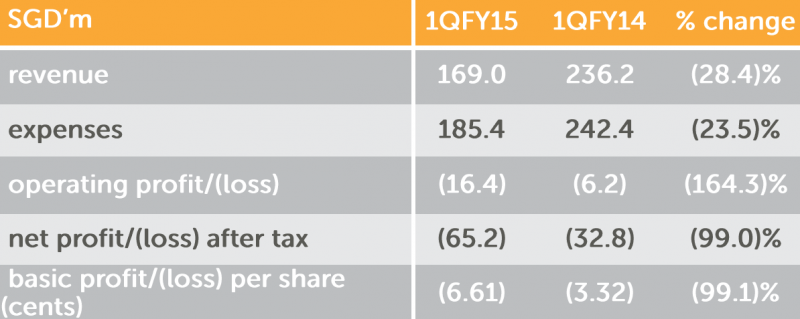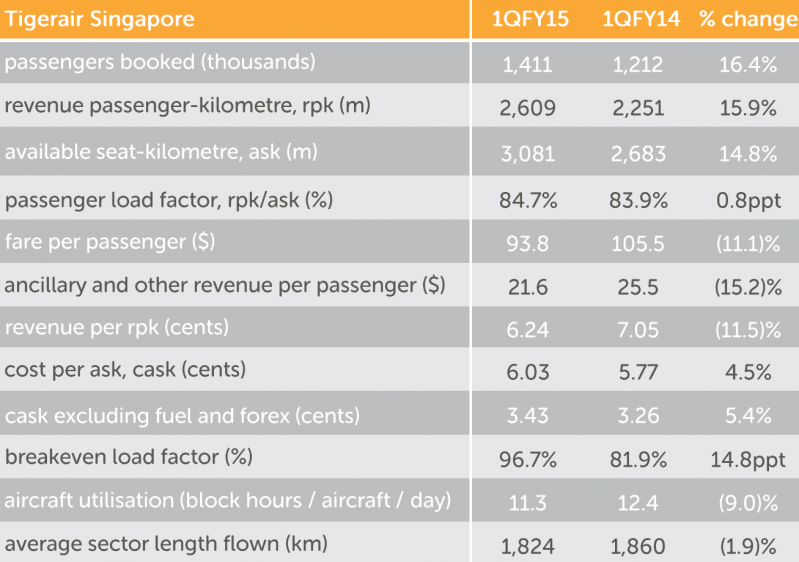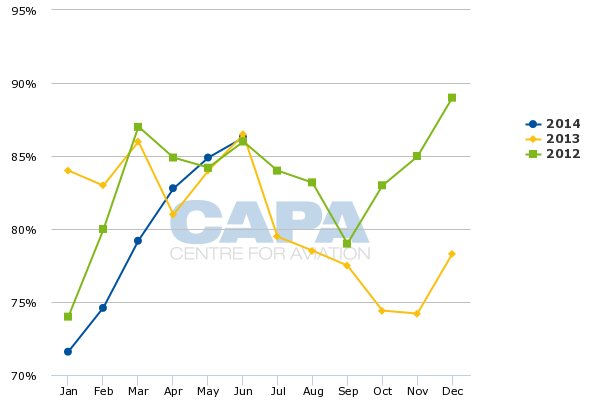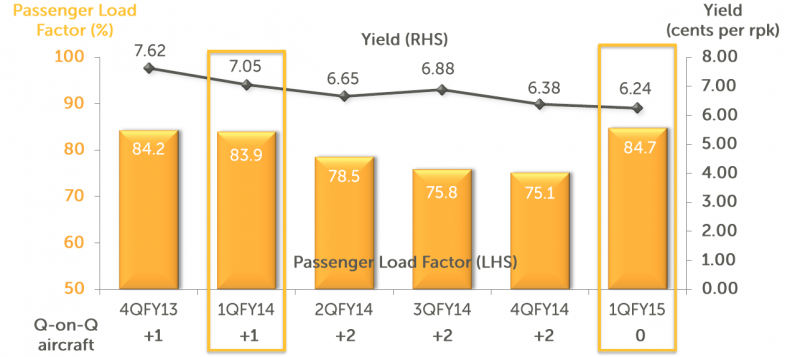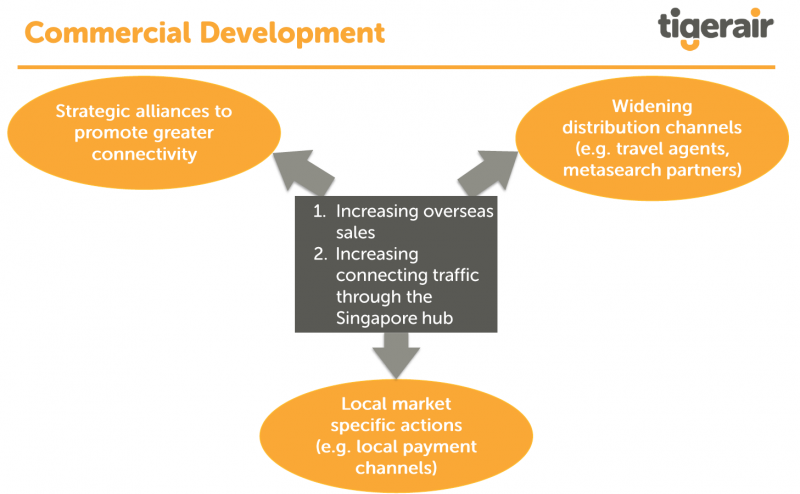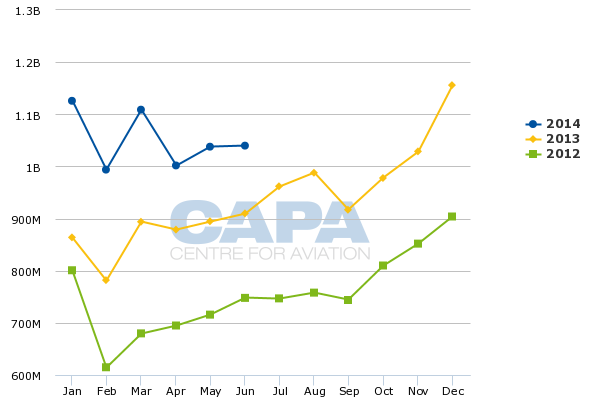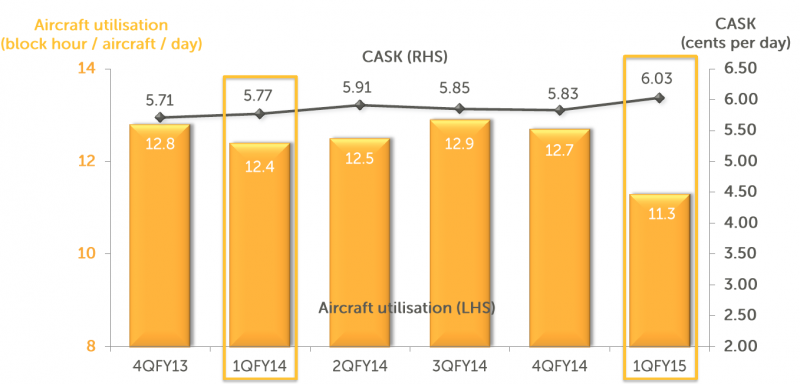Tigerair incurs another loss in 1Q. Turnaround hinges on increased transit traffic and partnerships
Singapore-based LCC group Tigerair continues to struggle, incurring a net loss of SGD65 million (USD52 million) for the quarter ending 30-Jun-2014 (1QFY2015). Tigerair Singapore was in the red for the fourth consecutive quarter and losses continued to mount at Tigerair Australia and its now shuttered Indonesian joint venture, Tigerair Mandala.
The Tigerair Group is in the process of implementing a new strategy aimed at improving profitability by driving more transit traffic at its Singapore hub, relying more on overseas sales and forging and deepening partnerships. Meanwhile the group will maintain capacity levels in Singapore, its only remaining Southeast Asian operation, as part of an effort to boost load factors and eventually yields in a challenging marketplace that is suffering from overcapacity.
The new strategy is necessary and could improve Tigerair's long-term outlook. But for at least the short term Tigerair's turnaround efforts face huge obstacles, including unfavourable market conditions and challenges finding new homes for its surplus aircraft.
Mandala accounted for over half of Tigerair's 1QFY2015 loss
The Tigerair Group's negative SGD65 million (USD52 million) result for 1QFY2015 represents a doubling of losses compared to the SGD33 million (USD26 million) net loss from 1QFY2014. It follows a net loss of SGD223 million (USD177 million) in FY2014 and a net loss of SGD45 (USD36 million) in FY2013, both of which were impacted significantly by losses at its joint ventures.
Tigerair Group financial highlights: 1QFY2014 vs 1QFY2013
The Singapore-listed group recorded a loss of SGD35 million (USD28 million) related to its approximately 40% stake in Mandala, which means the Indonesian carrier incurred a loss of about USD70 million in its final quarter of operation. This excludes a SGD15 million (USD12 million) provision to cover shutdown costs at Mandala, which ceased operations on 1-Jul-2014.
Mandala's cumulative losses totalled about USD230 million (excluding shutdown costs) in the 21 months the carrier operated as a Tigerair affiliate. As it transported only 3 million passengers during those 21 months Mandala had an average loss of over USD75 per passenger - a dismal performance, giving Tigerair little choice but to pull the plug as intense competition and unfavourable market conditions in Indonesia provided little hope for improvement. (Mandala relaunched operations in Apr-2012 following a 15-month suspension in which the carrier restructured under bankruptcy protection and secured Tigerair and Indonesian investment firm Saratoga as new shareholders.)
See related report: Tigerair Mandala suspension begins needed consolidation to Indonesian & Southeast Asian LCC sectors
Mandala was the last remaining Tigerair affiliate from Southeast Asia as Tigerair Philippines was sold to Cebu Pacific in Mar-2014 (before the end of Tigerair's FY2014). Tigerair still has a 40% stake in Tigerair Australia and a 10% stake in start-up Tigerair Taiwan, which is planning to launch services by the end of 2014. But these ventures are now managed by their majority shareholders, Virgin Australia and China Airlines, and (unlike the now defunct joint ventures in Southeast Asia) have independent fleet plans.
Tigerair's share of losses at Tigerair Australia for 1QFY2015 amounted to SGD14 million (USD11 million) but this did not factor into the group's overall net loss as it has capped its share of losses related to its investment in Tigerair Australia.
Based on these figures the Australian carrier incurred a loss of about USD27 million in Tigerair's 1QFY2015. Virgin Australia, which acquired a 60% stake in Tigerair Australia in 2013, will release a more complete set of financial figures for Tigerair Australia in Aug-2014 when it reports earnings for its fiscal year ending 30-Jun-2014.
Tigerair Singapore was again in the red in 1QFY2015 as overcapacity bites
The shutdown at Mandala along with the divestment of its entire stake in Tigerair Philippines and a majority stake in Tigerair Australia enables the group to focus on its core Singapore operation. New Tigerair Group CEO Lee Lik Hsin, who moved over from Tigerair 40% shareholder Singapore Airlines (SIA) in May-2014, has been tasked with turning around Tigerair Singapore.
The carrier recorded an operating loss of SGD20 million (USD16 million) in 1QFY2015 compared to an operating profit of SGD6 million (USD5 million) in 1QFY2014, which is the last quarter Tigerair Singapore was profitable.
Tigerair Singapore financial highlights: 1QFY2015 vs 1QFY2014
Over the past year Tigerair Singapore has struggled due to challenging market conditions and overcapacity in Singapore's short-haul market, which it was partially responsible for creating by pursuing overly ambitious capacity expansion. In FY2014 Tigerair Singapore ASKs surged by 26% as the carrier added several A320s, some of which the group would have preferred to place at affiliates but was unable to because of challenging conditions in the Philippines and Indonesia. Yields dropped by 10% while load factor dropped by 6.2ppt to 78.1% as RPKs, which increased by 16%, lagged behind the 26% ASK increase.
See related report: Tigerair restructures after recording a FY2014 loss. A Singapore Airlines takeover seems sensible
Since the beginning of FY2015 Tigerair Singapore has stopped adding aircraft as it has cancelled all its remaining A320ceo orders and grounded 12 of the 14 aircraft that were previously operated in the Philippines and Indonesia. But Tigerair Singapore's ASKs were still up 15% in 1QFY2015 on a year-over-year basis as a large portion of the capacity added in FY2014 came in the second half.
Tigerair Singapore has been able to start reversing a declining trend in load factors as its average load factor for 1QFY2014 improved by 0.8ppt to 84.7%. But the higher load factor came at the expense of yields, which dropped by 12% in the quarter.
Tigerair Singapore operating highlights: 1QFY2015 vs 1QFY2014
Apr-2014 marked the first time Tigerair Singapore's load factor was above 80% since Jun-2013. Prior to that the last time Tigerair Singapore's load factor was below 80% was Jan-2012.
Tigerair Singapore's load factor has been up on a month-over-month basis every month so far this calendar year, an encouraging sign.
Tigerair Singapore monthly load factor: Jan-2012 to Jun-2014
During a media call to discuss Tigerair's 1QFY2015 results, Mr Lee acknowledged the group's short-term focus is to improve load factor rather than yield. He said Tigerair will work on improving yields at a later stage.
On a quarter over quarter basis Tigerair Singapore's yield has dropped four out of the last five quarters - from a base which was already low. The hope is yields can eventually be improved as Tigerair's efforts to increase overseas sales, transit traffic and partnerships start to bear fruit.
Tigerair quarterly yields and load factor: 4QFY2013 to 1QFY2015
Tigerair has been very slow in growing transit and partnership traffic
Tigerair started to pursue partnerships and transit traffic during the 21 month tenure of previous group CEO Koay Peng Yen, marking a strategic shift as Tigerair previously insisted on sticking to a pure LCC model. But the speed with which Tigerair has so far built up transit traffic and partnerships has been extremely slow, frustrating SIA and its long-haul low-cost subsidiary Scoot.
Scoot and Tigerair initially forged an interline partnership in Oct-2012. The carriers began transferring passengers in early 2013 - at about the same time Tigerair introduced a connection product in Singapore. But the volume of passengers that connect between Tigerair flights and between Tigerair and Scoot has so far been extremely low.
Adopting a strategy to pursue more transit and partnership traffic is a no brainer. However, Tigerair has until now dragged its feet in rolling out initiatives to stimulate transit traffic within the group and with Scoot. Tigerair and Scoot have paid the price for the delays. The impact on Scoot, which needs short-haul feed to be viable, likely played a role in SIA's decision to increase its involvement in Tigerair including the appointment of Mr Lee.
More transit traffic for Tigerair is good for everyone
The new Tigerair strategy focusing on transit traffic and partnerships should benefit Tigerair, Scoot and Singapore overall.
Tigerair needs a much higher portion of transit traffic - both Tigerair to Tigerair and Tigerair to partner connections - in order to be competitive with Asia's other LCC groups. AirAsia and Jetstar both now have much higher portions of transit traffic than Tigerair.
"We need to market ourselves more like a network carrier rather than a point to point carrier," Mr Lee said during the media briefing, adding that in order to grow Tigerair cannot rely entirely on local traffic.
More transit traffic should also help boost sagging yields and eventually enable a resumption of expansion in Singapore. As CAPA has previously suggested, Singapore's Changi Airport needs LCC transit traffic to drive a new era of growth in what is otherwise a relatively mature market.
Passenger traffic growth at Changi slowed to only 1% in 1H2014 (to 26.6 million). Changi is now in the process of drafting initiatives aimed at stimulating more transit traffic. This is seen as a recognition that Changi is behind other airports in the region, including Kuala Lumpur International (KLIA) and Bangkok Don Mueang, when it comes to the emerging and fast-expanding LCC transit traffic sector.
See related reports:
- Singapore Changi's slowdown requires long-term strategic solutions, improved transfer traffic model
- AirAsia X drives 43% transit traffic at Kuala Lumpur's KLIA. Can Singapore follow the same recipe?
Tigerair is banking on anti-trust immunity for a Scoot alliance
Tigerair is confident a proposed enhanced alliance with Scoot, which it initially forged in late 2013 and is now pending approval from Singapore competition authorities, will be able to drive more transit traffic. Tigerair and Scoot are both eagerly awaiting the decision from the Competition Commission of Singapore (CCS), which if granted would allow the carriers to discuss coordinating schedules and pricing. The coordination is expected to focus on the four routes operated by both carriers - Bangkok, Hong Kong, Perth and Taipei.
The two carriers could potentially adopt other initiatives to stimulate Tigerair-Scoot transfers without requiring anti-trust immunity. But at least for now Tigerair is only focused on the proposed alliance - an approach which could backfire if approval is delayed.
Prior to Mr Lee's arrival Tigerair showed little initiative in trying to improve the existing partnership with Scoot outside the potential new areas of cooperation that become feasible under anti-trust immunity. Tigerair was also not as swift as it could have been in preparing and submitting its part of the application to CCS.
Little progress so far in Tigerair-SpiceJet partnership
Tigerair also has not yet shown a great deal of initiative at maximising its first partnership outside the SIA Group, with Indian LCC SpiceJet. Tigerair and SpiceJet forged a partnership in late 2013 and began interlining at the beginning of 2014 via Hyderabad. But the traffic volumes from the partnership have been practically non-existent.
The main obstacle is schedule coordination as Tigerair's only Hyderabad flight lands late at night, requiring passengers that book domestic connections onto SpiceJet to overnight at the Indian airport. This limits convenient connections to one direction (ex-India). Remarkably, it has not yet adjusted any of its Hyderabad flights to accommodate connections or added other connection points in India where Tigerair has more conducive flight times.
Tigerair and SpiceJet are now working on trying to coordinate their schedules. Certainly any adjustments are better late than never. But the fact Tigerair implemented the partnership, including investing in the IT links, and have had it in place for several months without a coordinated schedule illustrates a lack of focus. The arrangement is presumably also now made more complex as part owner Singapore Airlines is in the throes of establishing an Indian JV with the Tata group.
Tigerair also forged an interline partnership in Jan-2014 with Cebu Pacific (the partnership was announced at the same time as the deal to sell Tigerair Philippines to Cebu Pacific). But Tigerair only began selling joint itineraries with Cebu Pacific on 23-Jul-2014 while Cebu Pacific does not plan to start selling interline flights operated by Tigerair until Sep-2014.
While the delay in implementing the Cebu Pacific partnership is frustrating it does have more promise than the SpiceJet partnership and should start to bear fruit within the next few months, particularly as both carriers operate multiple flights between Singapore and the Philippines. (SpiceJet does not have any flights to Singapore.)
Mr Lee said for now Tigerair has no intention of seeking anti-trust immunity to coordinate schedules and sales with Cebu Pacific in the Singapore-Philippines market. But this would be a logical next step. A more comprehensive partnership between Tigerair and Cebu Pacific - and potentially between Tigerair, Cebu Pacific and SpiceJet - would improve all three carriers' competitiveness against larger LCC groups such as AirAsia and Lion.
See related report: Cebu Pacific becomes latest Tigerair partner. Can LCC alliances counterbalance AirAsia and Lion?
Could Citilink and Nok Air be Tigerair's next partners?
Mr Lee says Tigerair is also interested in expanding its portfolio of partners to include more LCCs but says it is too premature to identify specific carriers that the group has had discussions with. "We need alliances to expand the network. We are not limiting ourselves," Mr Lee said.
Tigerair would benefit from having partners in key markets such as China, Indonesia and Thailand. In Thailand a tie-up with Nok would be logical given that Nok has tied up with Scoot to establish a new Bangkok-based long-haul LCC.
Scoot also plans to tie up with Nok's short-haul operation at a later stage, leaving the door open for a Nok-Tigerair partnership particularly once Scoot and Tigerair start coordinating on the Singapore-Bangkok route. Thailand is currently Tigerair Singapore's largest single market accounting for nearly 20% of its total seat capacity, according to CAPA and OAG data.
In Indonesia a tie-up with Garuda budget subsidiary Citilink would be logical. Even if a Tigerair or SIA investment in Citilink is no longer on the table (Citilink has been seeking new strategic partners) a partnership would benefit both sides.
Indonesia is still an important market for Tigerair, which would be keen to use a partnership to fill the void left by Mandala just as it has used its partnership with Cebu Pacific to fill the void left by Tigerair Philippines. Although Tigerair Singapore has not backfilled the capacity previously provided by Mandala in the Indonesia-Singapore market, Indonesia is still Tigerair's second largest market and accounts for about 12% of its total seat capacity.
Finding a partner in China, which is Tigerair's fifth largest market (slightly behind India and Malaysia), could be more difficult as the Chinese domestic market is not yet significantly penetrated by LCCs. But Tigerair could potentially instead partner with Chinese travel agents.
Tigerair is now seeking to increase sales in China as part of its effort to boost overseas revenues. The group also is seeking to widen its distribution channels as part of its overall new strategy. Working more closely with travel agents in China would help achieve both of these objectives in an important market that relies heavily on offline bookings.
Tigerair strategic initiatives under new CEO Lee Lik Hsin
While Tigerair has been able to rely heavily on the web for distribution in the Singapore market it recognises it needs to work more closely with agents in markets such as China. More agent sales could also help boost yields and transit traffic.
Tigerair adjusts network while maintaining flat capacity
As transit traffic increases and new distribution channels are opened Tigerair will re-evaluate its network to see where it can potentially open new routes or increase frequencies. Overall Tigerair is planning to keep capacity flat but that does not preclude capacity increases in some markets while decreasing others.
Tigerair is implementing several network adjustments in 2QFY2015 including the termination of services to Trivandrum from 23-Sep-2014. The carrier is also cutting capacity on several routes including Bangkok, Chennai, Dhaka, Ho Chi Minh, Jakarta, Krabi, Kuala Lumpur, Langkawi and Penang. Capacity is being added to Manila, which is Cebu Pacific's main hub and illustrates the importance of partnerships.
Mr Lee said further network rationalisation is possible but the carrier also does not rule out launching new destinations, particularly routes that could become viable as it seeks to leverage the Singapore hub and pursue more transfer traffic.
At least for the remainder of this year Tigerair plans to keep monthly ASKs at their current level - just over 1 billion. Tigerair Singapore surpassed the 1 billion ASK level for the first time in Nov-2013 and has kept capacity relatively flat over the last seven months. The decision to take a hiatus from adding capacity is sensible as the capacity added over the last two years proved to be overly ambitious.
Tigerair Singapore monthly ASKs: Jan-2012 to Jul-2014
The flat capacity levels since the beginning of 2014 however have come at the expense of aircraft utilisation levels as Tigerair Singapore has added aircraft, including two A319s that had been operated by Tigerair Philippines.
Tigerair Singapore reported 11.3hrs of average utilisation in 1QFY2015, a decrease of 9% compared to 1QFY2014. The lower utilisation pushed up unit costs by 5%, making it virtually impossible to be profitable given the current highly competitive environment and pressure on yields.
Tigerair Singapore average aircraft utilisation rates and CASK: 4QFY2013 to 1QFY2015
Tigerair is aiming to improve utilisation rates in the coming quarters. But it is unclear how this will be achieved as Tigerair Singapore plans to keep ASK levels constant and is unlikely to reduce the number of aircraft in its fleet. In fact Tigerair says it is still reviewing options for the last four aircraft which had been operated by Mandala, leaving open the possibility the Tigerair Singapore fleet could again grow by up to four aircraft.
These four A320s are now grounded, joining the eight A320s (five from Mandala and three from Tigerair Philippines) which Tigerair decided to ground earlier this year. But the group has so far only decided to remarket the initial eight aircraft while it continues to review options for the additional four aircraft, including remarketing and putting the aircraft in Singapore.
Tigerair's turnaround also hinges on ability to remarket grounded aircraft
Tigerair included a one-time provision of SGD25 million (USD25 million) in 4QFY2014 to cover the grounding of the initial eight aircraft. It has since been trying to sublease the aircraft but has not yet been able to conclude any deals. The group will likely have to incur additional charges if it is not able to sublease the aircraft within the next couple of months - or if it is only able to sublease the aircraft at a monthly rate below what it is paying.
As a result the grounded aircraft pose a potential risk for Tigerair and could end up being a drain during an already challenging period. Tigerair needs to move on and focus on turning around its Singapore operation without the distraction and cost of excess aircraft.
Tigerair does not have much time to wait for its new strategy to bear fruit and for the grounded aircraft to be remarketed. The group already had to undertake multiple rights issues in recent years which were only subscribed to by SIA. As a result SIA increased its stake in Tigerair to 40% and extended Tigerair a loan which can be converted into a further 13% stake. A majority stake of over 50% would trigger a mandatory takeover bid.
Tigerair has stated it is again exploring the possibility of raising more capital. Given the challenging market conditions and its relatively bleak short to medium term outlook it is unlikely any initiative to raise more capital will generate interest outside SIA.
SIA for now prefers to keep Tigerair independent despite an increasingly strong preference from the investment community for Tigerair to be folded under the SIA Group and merged with Scoot. The upcoming push by Tigerair's new management team to improve yields and profitability by focusing more on partnerships and transit traffic could be the last roll of the dice. If Tigerair is not able to turn the ship around an SIA takeover would become inevitable.
